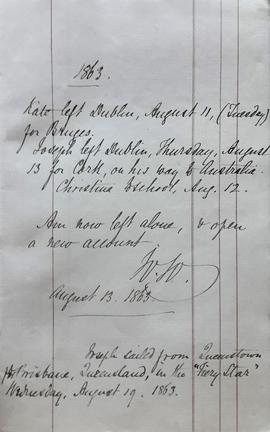Bound volume containing copy correspondence of the Most Rev. Paul Cullen, Archbishop of Dublin, with Fr. Lawrence Gallerani OSFC, Capuchin Commissary General, relating to the proposed building of a new Capuchin church on North King Street and to a controversy with the clergy of St. Michan’s over the site of the proposed church.
• On 28 Dec. 1861, Fr. Lawrence wrote: ‘… finding it impossible to get other ground near the Chapel for the building of a convent unless on a lease of 30 years, all these reasons induced me to look for another place sufficiently large for a convent and chapel. This place I have succeeded in finding in North King Street (about 200 yards from our present Chapel) and is at present occupied by the houses numbered 47, 48, 49, 50. The persons in actual possession of these houses will give up their respective interest in them for the sum of £500’.
• In reply, Archbishop Cullen affirmed that he had no objection to the undertaking but feared that it would ‘very difficult to get money in these times of distress to carry out the vast enterprise in which you wish to engage …’. 3 Feb. 1862.
• A memorandum follows which notes that not long after the receipt of the aforementioned letter from Archbishop Cullen, the Capuchin friars ‘concluded a contract with Mr. [Patrick] Regan who held by lease the two houses of nos. 49 and 50 North King Street, agreeing to give him £350 for his interest in said lease … [and] the entire community came from 18 Queen Street, to dwell in the aforesaid houses …’. An agreement was also reached in respect of nos. 47 and 48 North King Street. c.July-Aug. 1862.
• On 25 Sept. 1862, Fr. Lawrence received a note from Archbishop Cullen enclosing a statement from the parish priest and curates of St. Michan’s protesting against the building of the projected North King Street Church. The statement averred that the diocesan clergy are ‘menaced with another loss in as much as the Capuchin Fathers are about to build a new Church in North King Street’ and asked ‘for protection of the Archbishop against this threatened injury’.
• In response, Fr. Lawrence informed the Archbishop that if the Capuchins were ‘compelled to discontinue the work we would not only sustain a loss of the above large sum, but we would also be obliged by our contract to pay the balance due which is about £1,200, while the premises under such circumstances would be comparatively valueless to use … in as much as a great portion of them has been already pulled down …’. 26 Sept. 1862.
• Fr. Lawrence later reminded the Archbishop that the Capuchins had been ‘canonically established in Dublin, in the locality of Church Street, and … continued there for the long period of 250 years’. He also referred to the ‘ruinous state’ of the old Capuchin Church on Church Street: ‘I, at the same time, caused professional men to inspect the Church and they told me that … if it were not rebuilt its tottering walls would cause the death of the faithful who attended it. Moreover, its site being for many years surrounded with every kind of filth … the air is very unhealthy more particularly in the summer … and, as everyone in Dublin is aware, it is the centre of every immorality, and is surrounded by the most barefaced prostitutes’. 7 Dec. 1862.
• Another short memorandum follows which notes that the Capuchins finished their new friary on North King Street and ‘every possible exertion was made to buy three yards extending to North Brunswick [Street] at the rear of the new Convent … with the intention of building the Church on the site of the said yards’. When this plan was frustrated by the opposition of a neighbouring landlord, Fr. Lawrence again petitioned Archbishop Cullen ‘about building the Church on the site originally proposed on North King Street’ and reminded him that ‘religious regularity cannot be carried out without the necessary accommodation’. He also stated the Capuchins ‘have no money to make a new purchase’ and asked the Archbishop to ‘advance us the sum which will come to us out of French funds at the death of Miss McNulty (who is at present upwards of 80 years of age)’. 16 Jan. 1864.
• Archbishop Cullen informed Fr. Lawrence that he would not oppose the building of a new church on ‘North Brunswick Street where the Carmichael School was’. He added: ‘I must say that I think the site is not one where a church was required, and that in the present distressed state of the country, and whilst some recent scandals are fresh in the minds of the people, there may be serious doubts, as to the raising of the funds’. 21 Feb. 1864.
The volume also contains a loose sheet titled ‘Notabilia … relating to the Capuchins of Dublin, written for the satisfaction of all’. c.July 1856. This two-page memorandum was probably written by Fr. Augustine Dunne OSFC (1833- 1860), secretary to the Commissary General of the Capuchins of Ireland. It refers to the Baron Hale bequest. The memorandum reads: ‘There is a bequest to the community of 100 pounds sterling left by the late Baron Hale, the 73 interest of which was always spent in the celebration of masses. … They have always been said up to the year 1855, but since that up to the present year 1856, they have been neglected’.
See the memorandum and notes compiled by Fr. Stanislaus Kavanagh OFM Cap. on the Baron Hale Bequest at CA CS/2/3/5.


